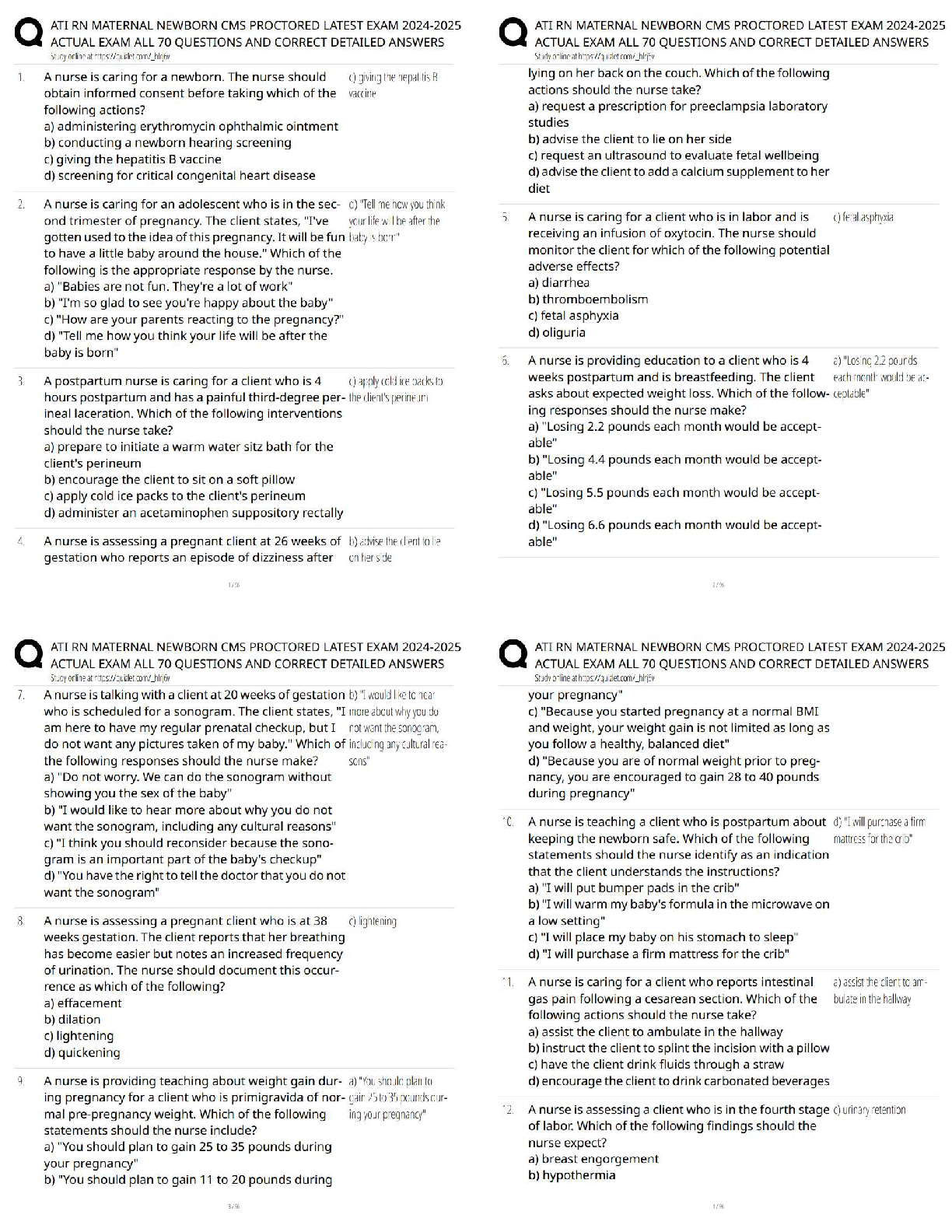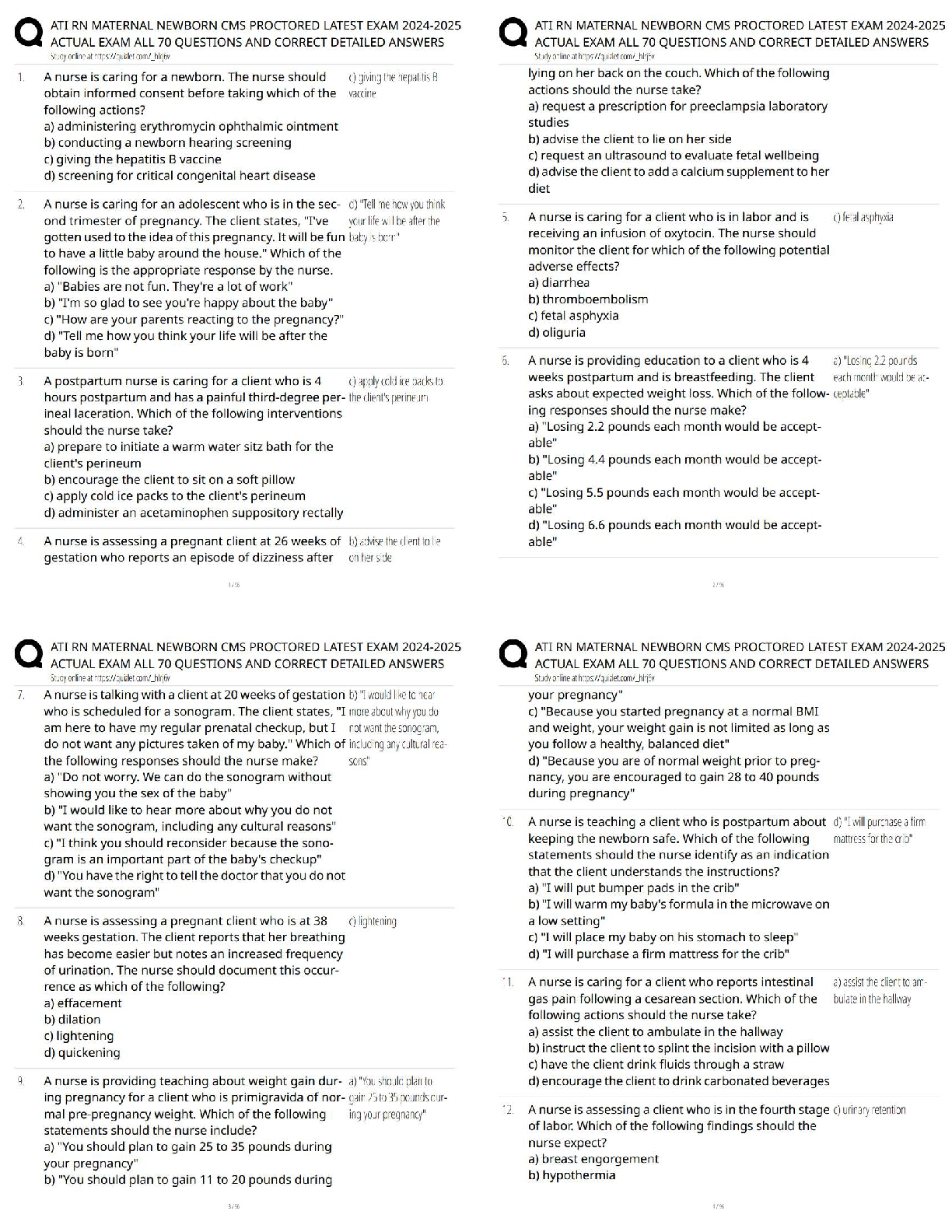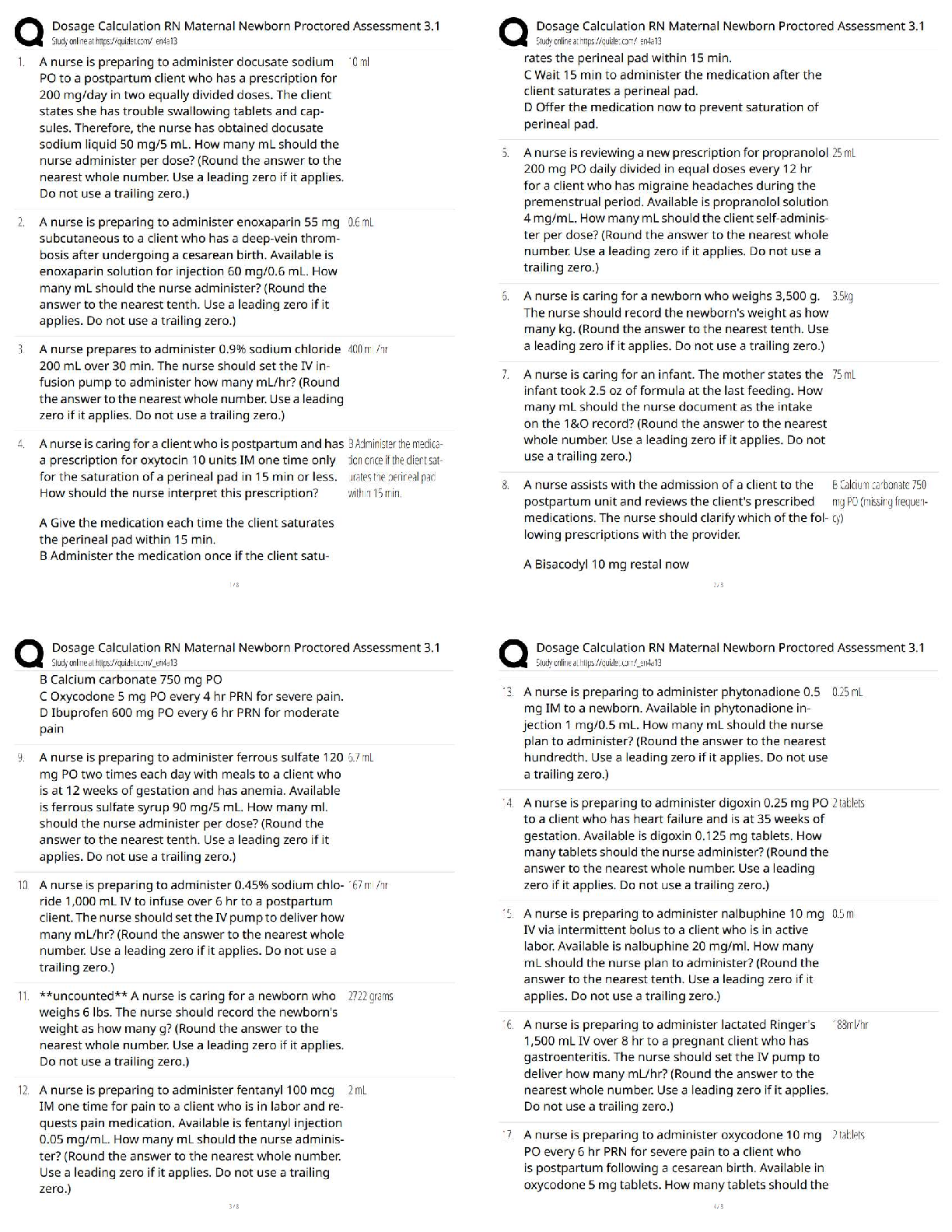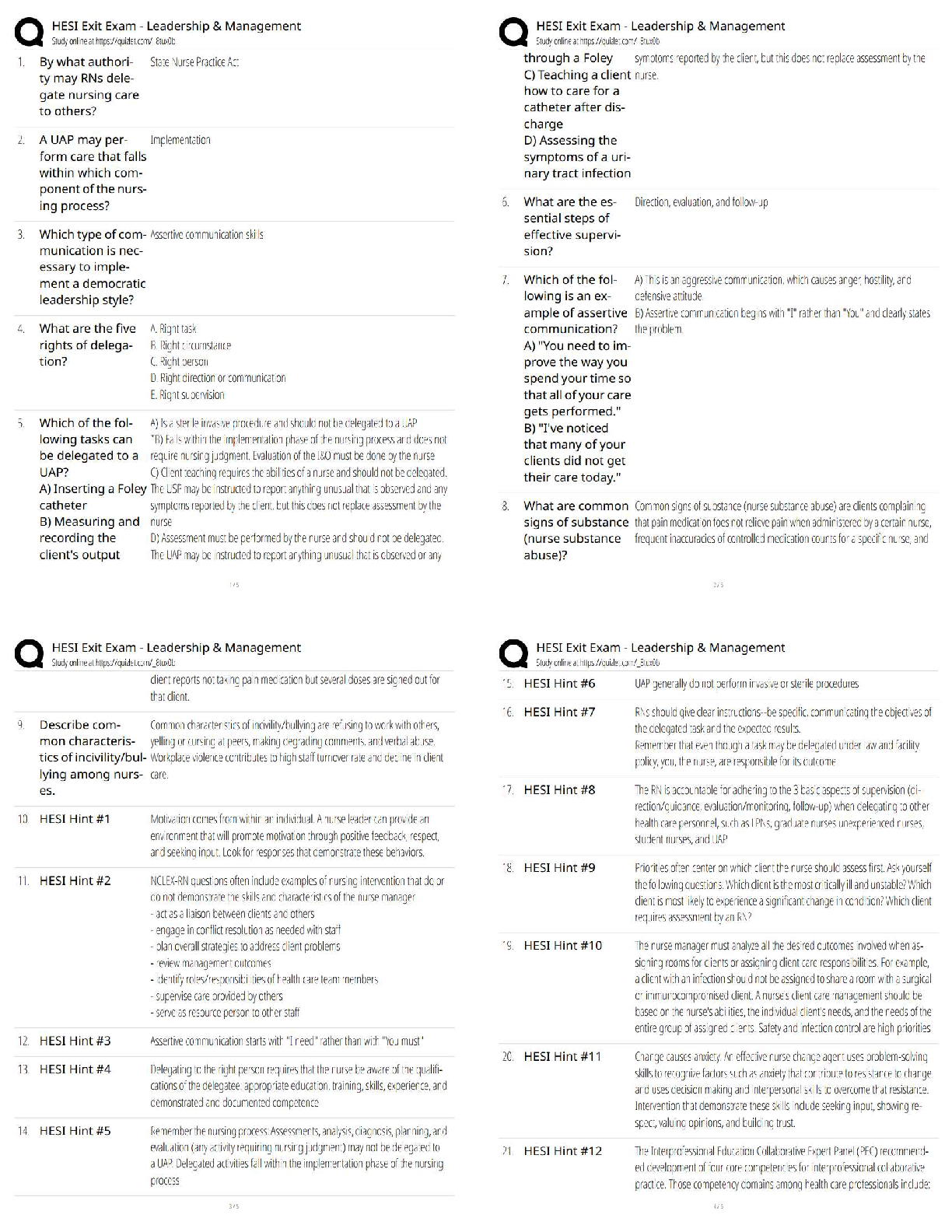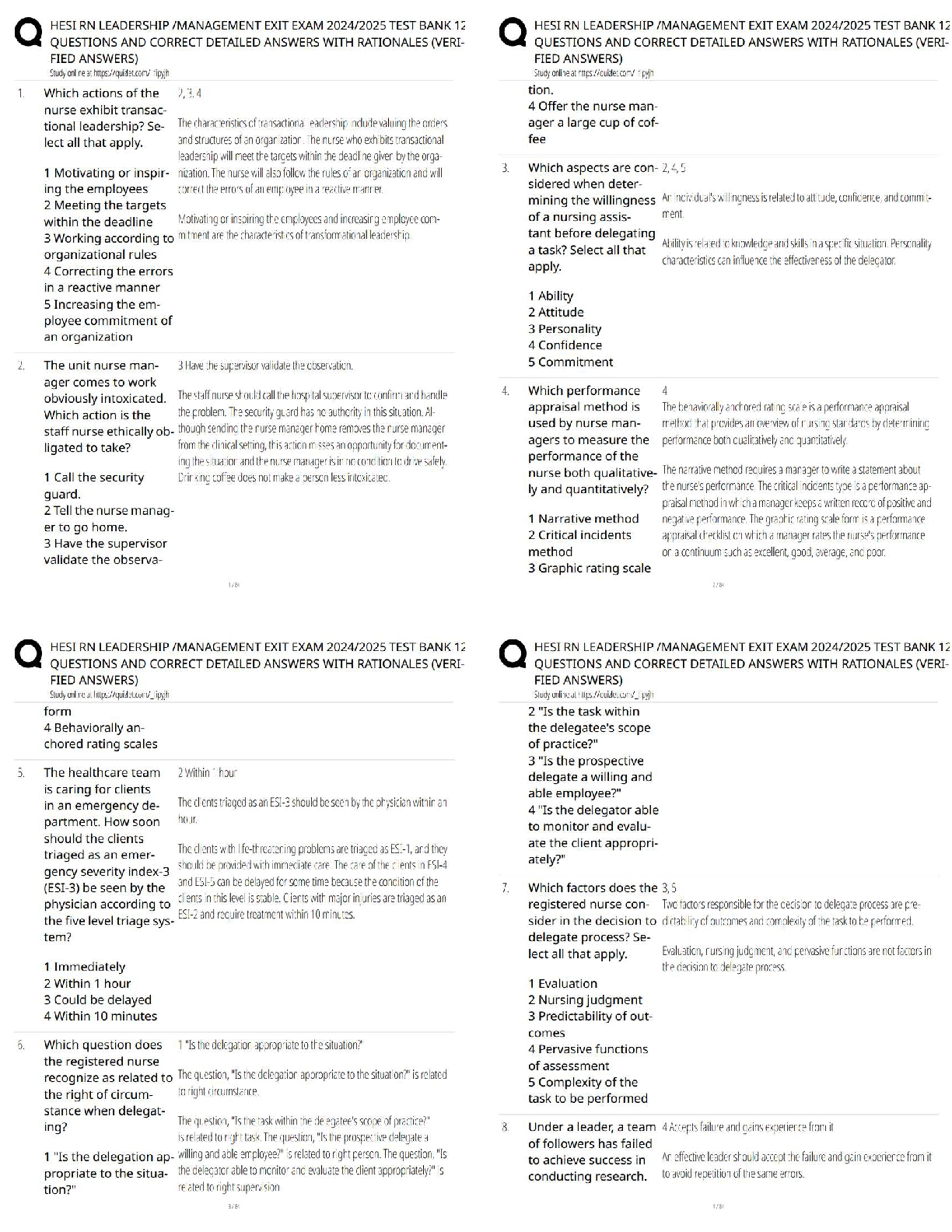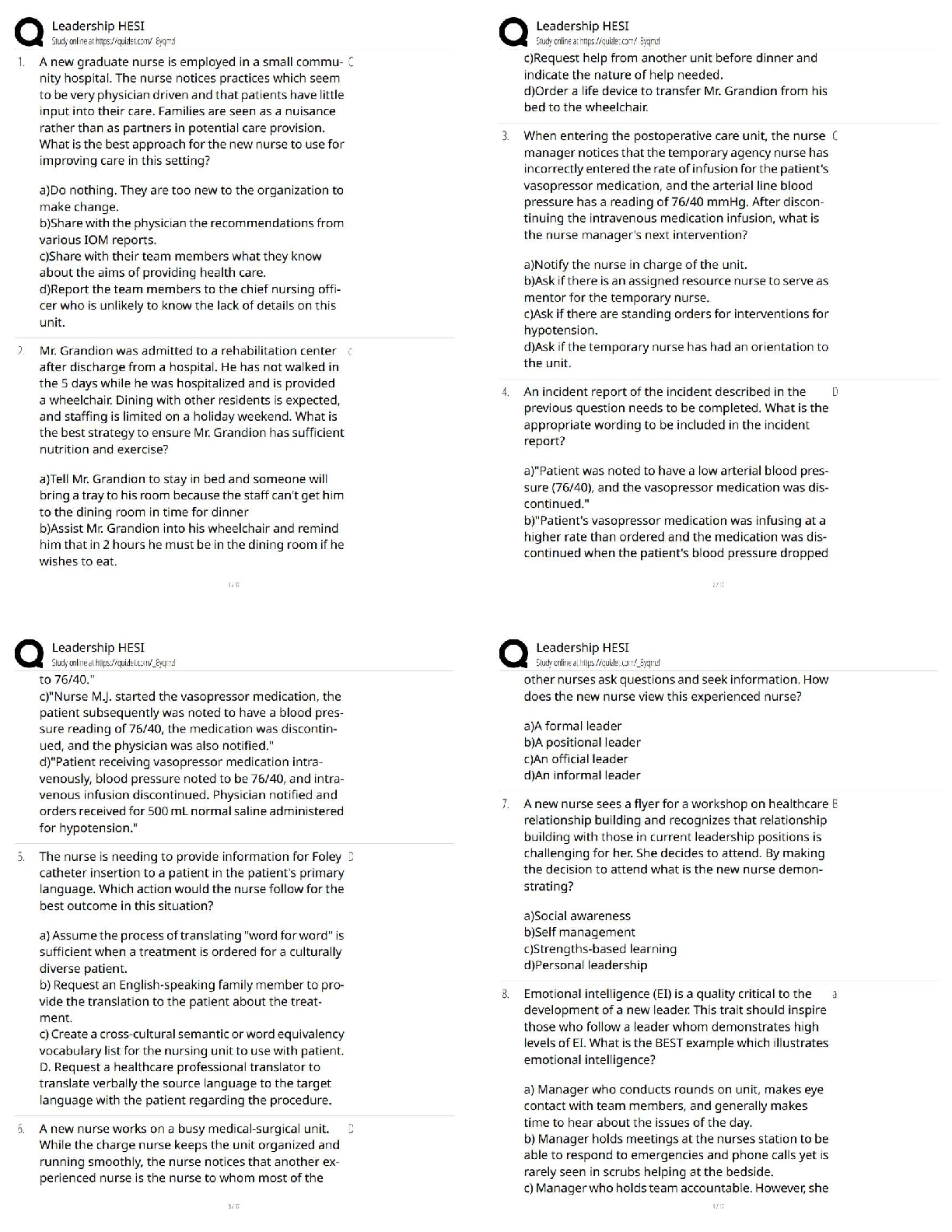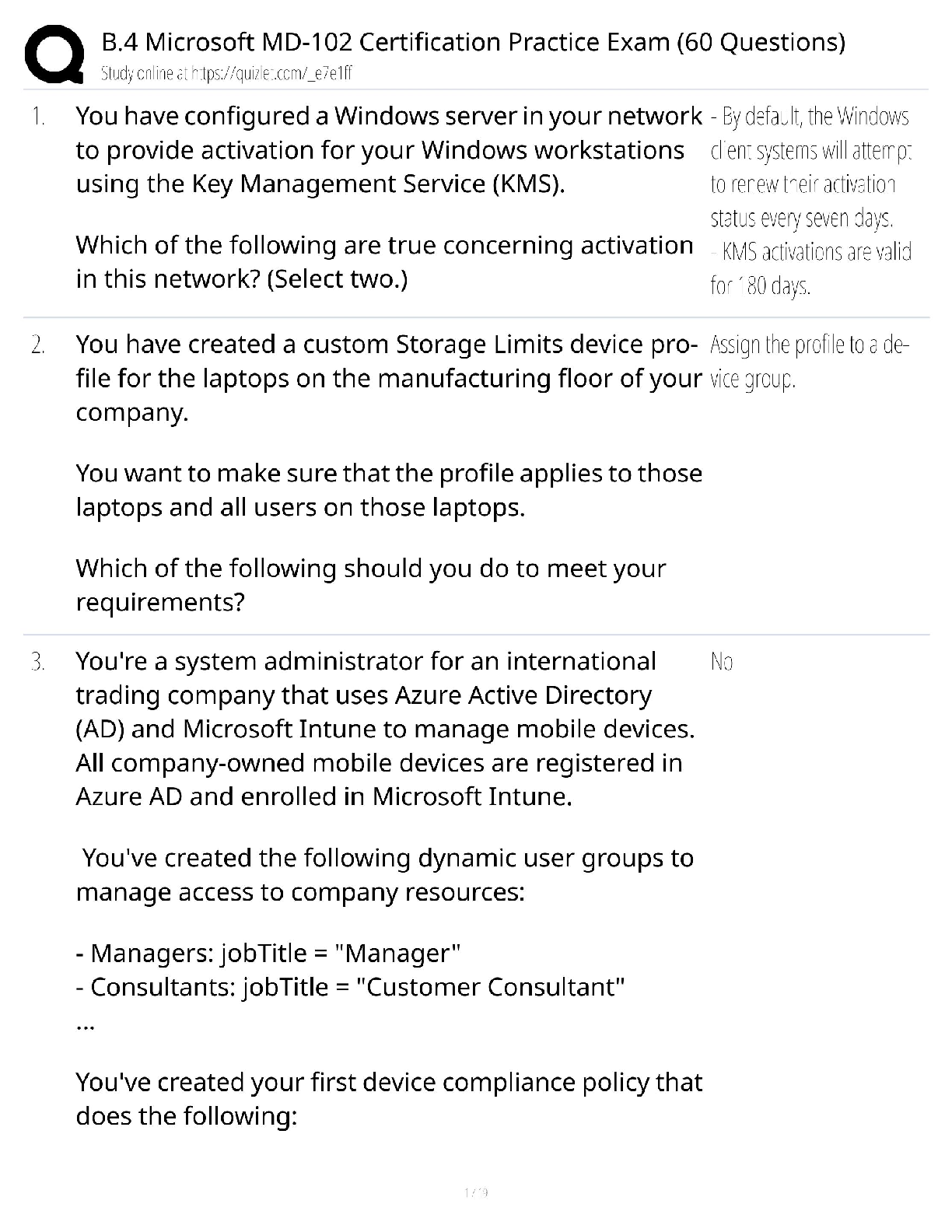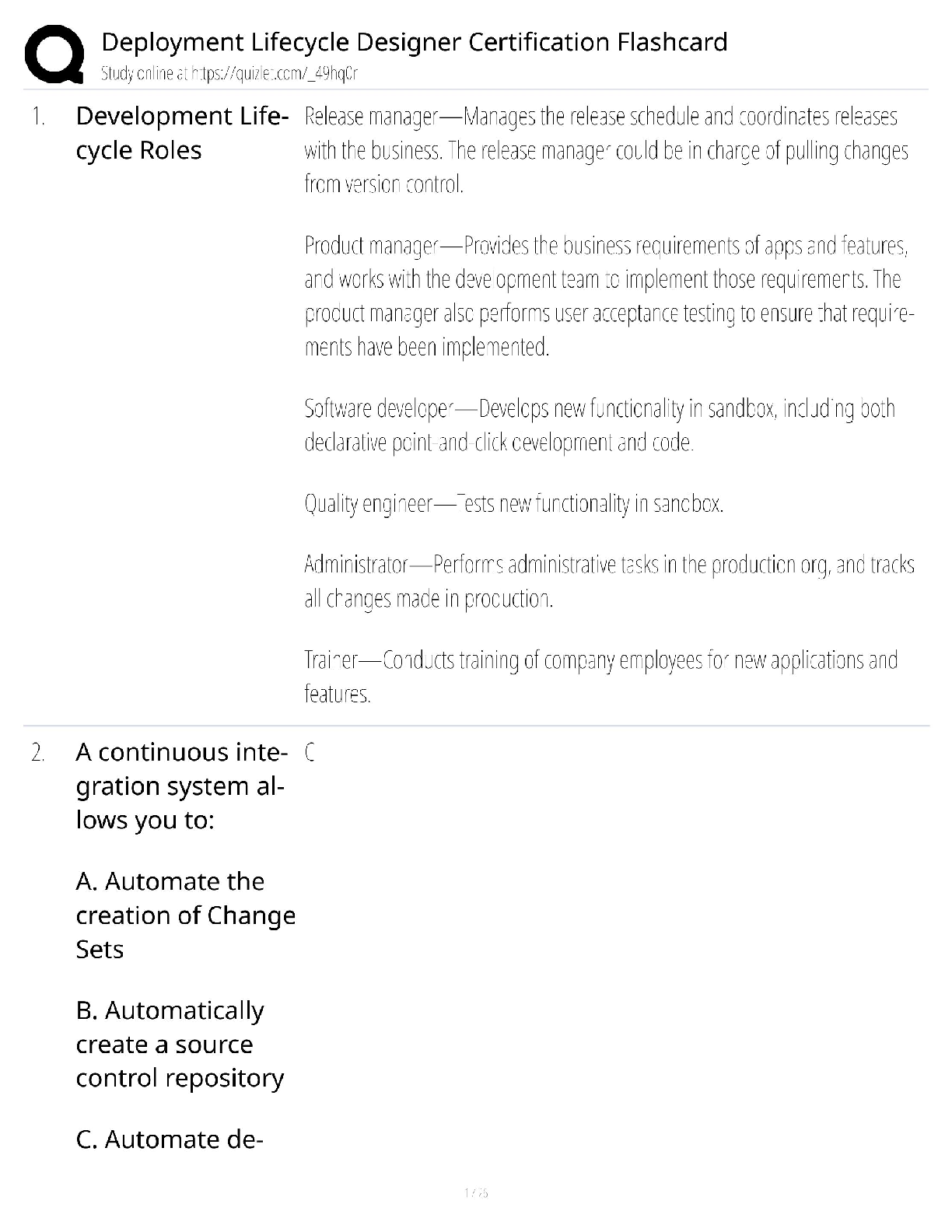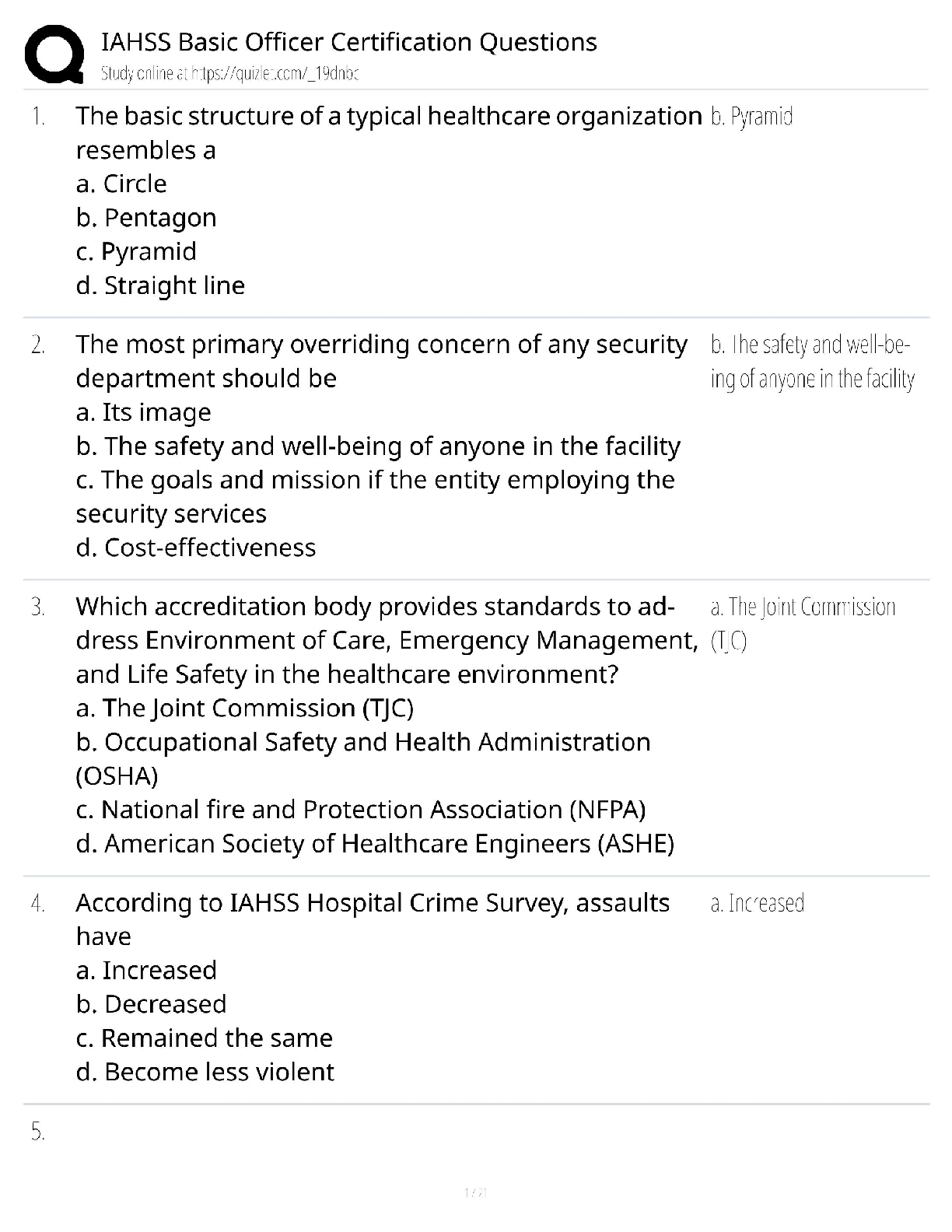Systems Analysis and Design > QUESTIONS & ANSWERS > MIS 307 CHAPTER 1-4 UNIT 1 EXAM KEY | Mississippi State University (All)
MIS 307 CHAPTER 1-4 UNIT 1 EXAM KEY | Mississippi State University
Document Content and Description Below
Mississippi State University MIS 307 SPRING 2022 CHAPTER 1-4 UNIT 1 EXAM KEY MULTIPLE CHOICE (Answer on green scantron with no. 2 pencil) 1) ________ were developed to make systems developers' ... work easier and more consistent. A) Data analysis tools B) Computer-aided software engineering (CASE) tools C) Software designing tools D) Modeling tools 2) _______________ is a systems development approach characterized by short term deliverables to the customer. A) Agile systems development B) Supply chain management systems development C) Analytical processing systems development D) Customer relationship management systems development 3) Which of the below is a traditional methodology used to develop, maintain, and replace information systems? A) Prototyping B) OOAD C) RAD D) SDLC 4) What is the first phase in the Systems Development Life Cycle? A) Analysis B) Design C) Planning D) Procedure 5) Which of the below is NOT a true statement regarding the SDLC? A) It is a highly linked set of phases whose products feed the activities in subsequent phases. B) The different phases are clearly defined. C) The relationships between phases are well specified. D) It is a rapid method to prototype and develop an application. 6) As the _________, Barbara has the primary responsibility to articulate the business process to the systems analyst for design of the new software development project. A) Chief information officer B) Primary user of the system C) Methodology specialist D) Business analyst 7) ________ is/are the property that occurs when entity types or object classes are arranged in a hierarchy and each entity type or object class assumes the attributes and methods of its ancestors, that is, those higher up in the hierarchy. A) Inheritance B) Objects C) Participatory design D) Object-oriented analysis and design 8) ________ is the practice of turning over responsibility of some to all of an organization's information systems applications and operations to an outside firm. A) Outsourcing B) Reuse C) Nearshoring D) Time to market 9) Which firm is best known for its Enterprise Resource Planning software solution? Hint: In class, I mentioned that Ole Miss uses this solution. A) SAP AG B) Oracle C) Microsoft D) Google 10) Why is open-source software different than the other types of software? A) Companies make money by offering maintenance contracts. B) It is available via the Internet. C) The source code is free. D) Only major corporations offer it. 11) When an organization’s own IT personnel develops and manages the software system for their organization it is referred to as being _____________? A) On Prim B) Prepackaged software C) Off the shelf D) Open source 12) Which of the following is a characteristic of off-the-shelf software? A) The Code is available to see, copy, and edit freely B) No licensing fee C) The software is generally not highly customizable D) It is developed by a world wide collaborative community of coders 13) Salesforce.com is an example of ___________. A) IT service firms B) in-house developers C) cloud computing D) ERP 14) ________ refers to the use of previously written software resources, especially objects and components, in new applications. A) Reorganization B) Reuse C) IT vendor support D) Software 15) Which of the following is an organization that hosts and runs computer applications for other companies, typically on a per use or license basis? A) ERP firm B) Cloud computing application provider C) The Internet D) A software analyst 16) Which of the following is NOT a part of the project management process? A) Planning B) Initiating C) Executing D) Adjoining 17) ________ is a controlled process of initiating, planning, executing, and closing down a project. A) System design B) System analysis C) Project scheduling D) Project management 18) In class I referred to this term that describes when a company is investing in research and development for a tech product but is still in the process of trouble shooting the problems of the product before introducing it to the market. A) Bleeding Edge B) Cutting Edge C) Mass Market D) Protocol customization 19) During ________, the project manager performs several activities to assess the size, scope, and complexity of the project and to establish procedures to support subsequent activities. A) Project bidding B) Project development C) Project initiation D) Project delivery 20) What is the next step taken after project initiation? A) Project bidding B) Project planning C) Project execution D) Project development 21) ________ is the process of dividing the project into manageable tasks and logically ordering them to ensure a smooth evolution between tasks. A) Work breakdown structure B) Task breakdown structure C) Project breakdown structure D) Management breakdown structure 22) A Gantt chart is the graphical representation of a project that shows each task as a ________ bar whose length is proportional to its time for completion. Hint: I referred to this in class a glorified “To Do List”. A) Vertical B) Linear C) Curve D) Horizontal 23) The term ________ refers to concept that an application will be easily viewable and workable on a variety of devices such as laptops, mobile phones, or tablets. A) Scope B) Scalability C) Inheritance D) Scrum 24) A ___________ refers to a sequence of task activities that have to be completed before the next set of tasks are undertaken. A) Duration B) Order C) Sequence D) Critical Path 25) ________ refers to the amount of time a task can be delayed without delaying the early start of any immediately following tasks. A) Response time B) Lead time C) Shortest time D) Slack time 26) Georgia was contacted by the CEO to research if adding a new data center makes sense for the organization from an economic stand point. Georgia agreed to perform a(n) ________. A) A systems service request B) System enhancement study C) Feasibility study D) End product 27) The term __________ refers to a set of software components that link an entire organization. A) Information Silo B) Departmental Applications C) Open Source D) Enterprise systems 28) Which of the following is a characteristic of top management when choosing an IS project selection? A) Departmental level focus B) Bottom – Up Collaboration C) Enterprise wide consideration D) Individual level focus 29) Which group is best suited for determining cross-functional and cross-departmental needs of an organization? A) Business unit B) Steering committee C) Functional manager D) Development group 30) Which of the following groups does NOT identify a bottom-up development project? A) Business units B) Managers C) Top Management D) IS development group EXCEL APPLIED SECTION (Perform the tasks on the template in Blackboard) 1. (1 point) Orientate cell A2 to a 47 degree angle. 2. (1 point) Apply the Title Cell Style to A5:G6. Apply the Heading 3 cell style to A7:G7. Apply the Total cell Style to A20:G20. 3. (1 point) Apply formatting such that a fixed dollar sign is applied to cells F8:G8 and F20:G20. Apply formatting such that a floating dollar sign is applied to cells F21:G21. 4. (1 point) In cell G8, enter a formula to calculate commission that will: a. multiply the receipt value in cell F8 by its appropriate Complex Commission Rate in cell B2. b. Use absolute referencing in the above formula to lock in the Complex Commission Rate’s (or B2’s) row reference. c. Use the fill handle to copy the formula in cell G8 down to cell G19 such that the formatting is not copied down along with the formula. 5. (1 point) Total the cells F20:G20 for the Receipts and Commissions columns respectively using an appropriate function. 6. (1 point) Average the cells F21:G21 for the Receipts and Commissions columns using an appropriate function, and edit it to not include the total row. 7. (1 point) Best fit the width so that the numbers are visible in cell G20. 8. (1 point) Write a conditional formatting rule in cells F8:F19 such that if Receipts are below $60,000.00 the background of the cell will be formatted as red with a white font. 9. (1 point) Change the name of the Sheet1 tab to Commissions. 10. (1 point) Change the color of the sheet tab to Green. 11. (1 point) Delete the tabs Sheet2 and Sheet3. 12. (1 point) Add a second line to cell B7 and C7 such that the word “Name” is on the second line of the cell. 13. (1 point) Add a header that reads the name of the sheet and places it in the center portion of header. 14. (1 point) On the left side of the header area add the code that displays the page number and total number of pages automatically, so that it displays Page 1 of 1. 15. (1 point) In cell A28, type whether this Excel lesson was a refresher, you learned something new, or you learned several things that were new to you. (I’m trying to get a feel for what the class’ experience level is with Excel) [Show More]
Last updated: 6 months ago
Preview 1 out of 6 pages
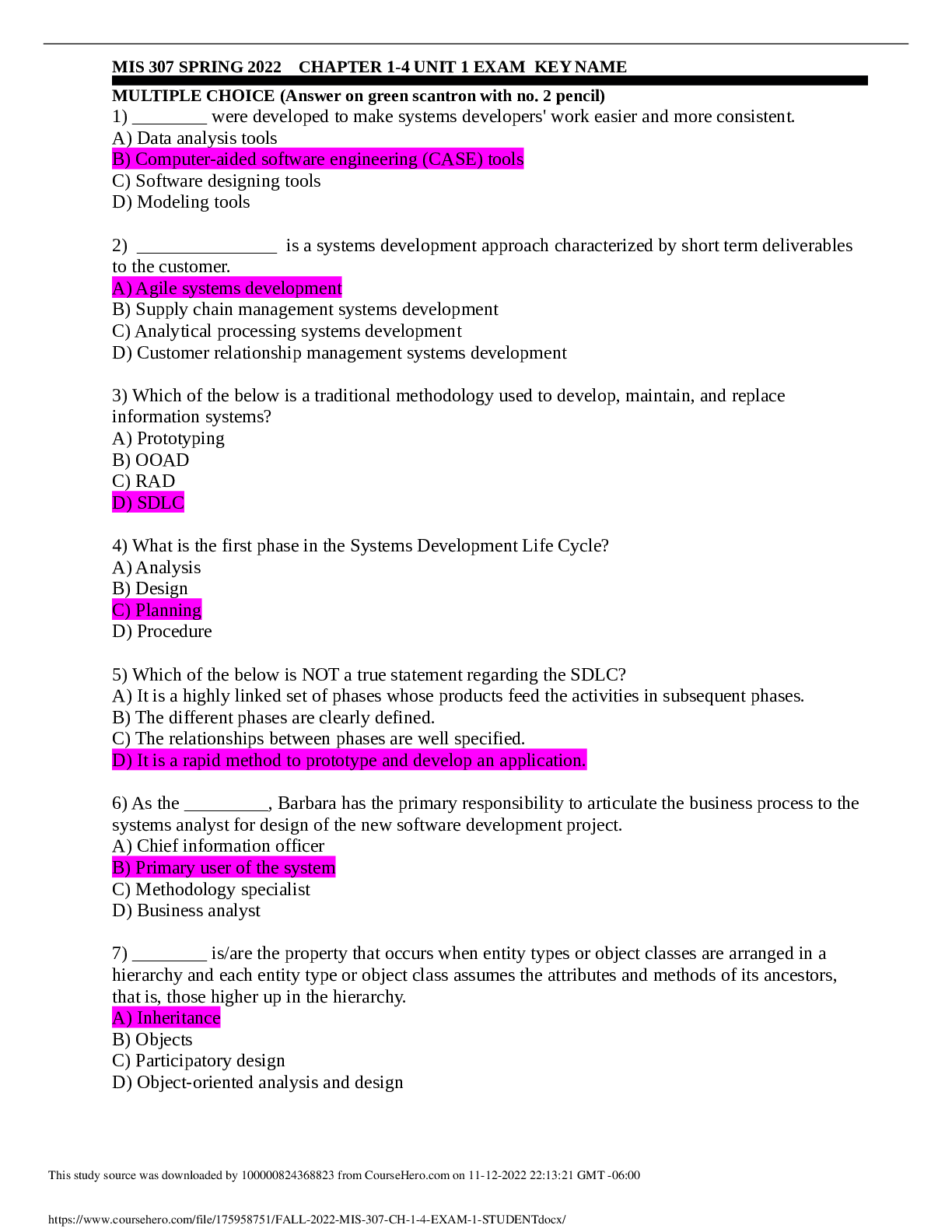
Buy this document to get the full access instantly
Instant Download Access after purchase
Buy NowInstant download
We Accept:

Reviews( 0 )
$10.00
Can't find what you want? Try our AI powered Search
Document information
Connected school, study & course
About the document
Uploaded On
Nov 13, 2022
Number of pages
6
Written in
All
Additional information
This document has been written for:
Uploaded
Nov 13, 2022
Downloads
0
Views
103


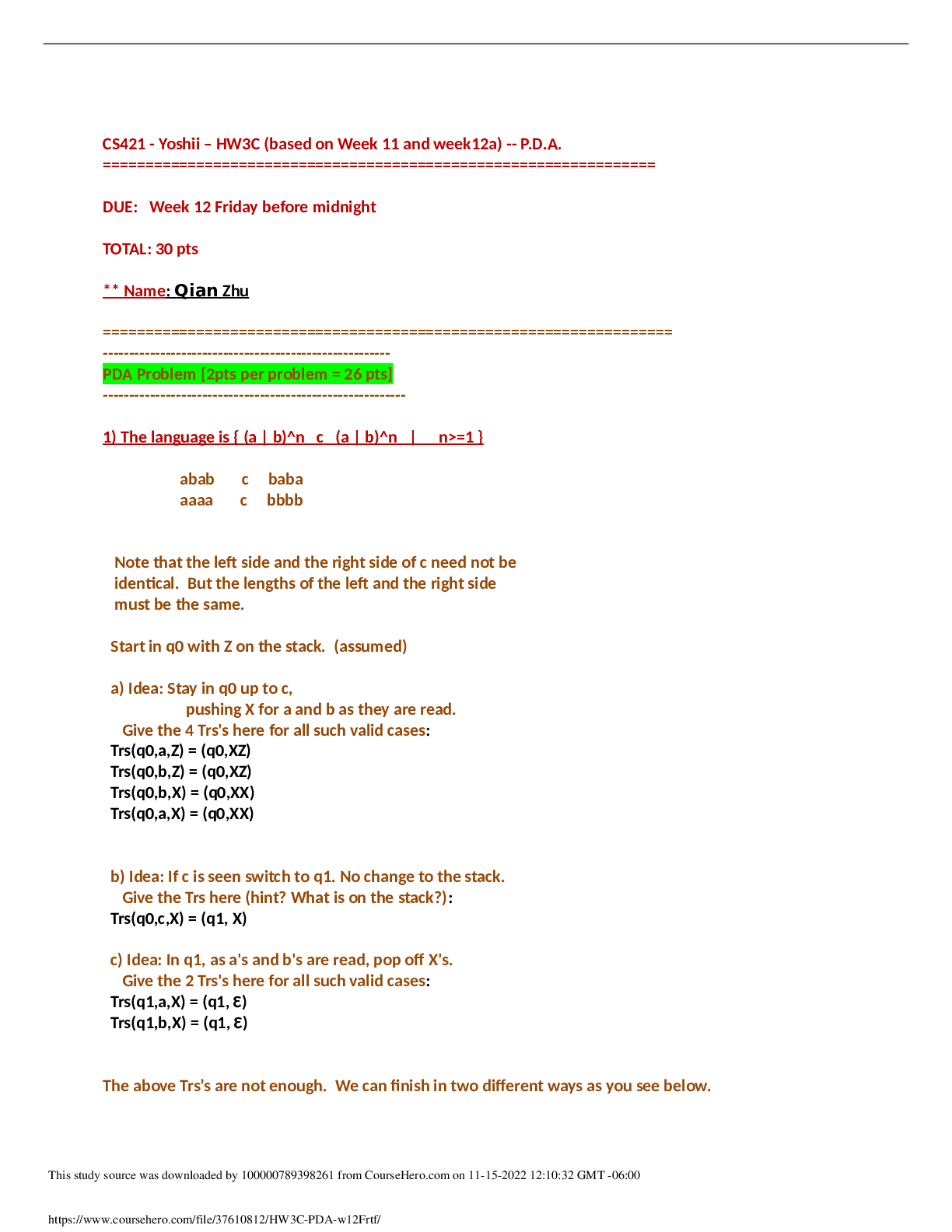


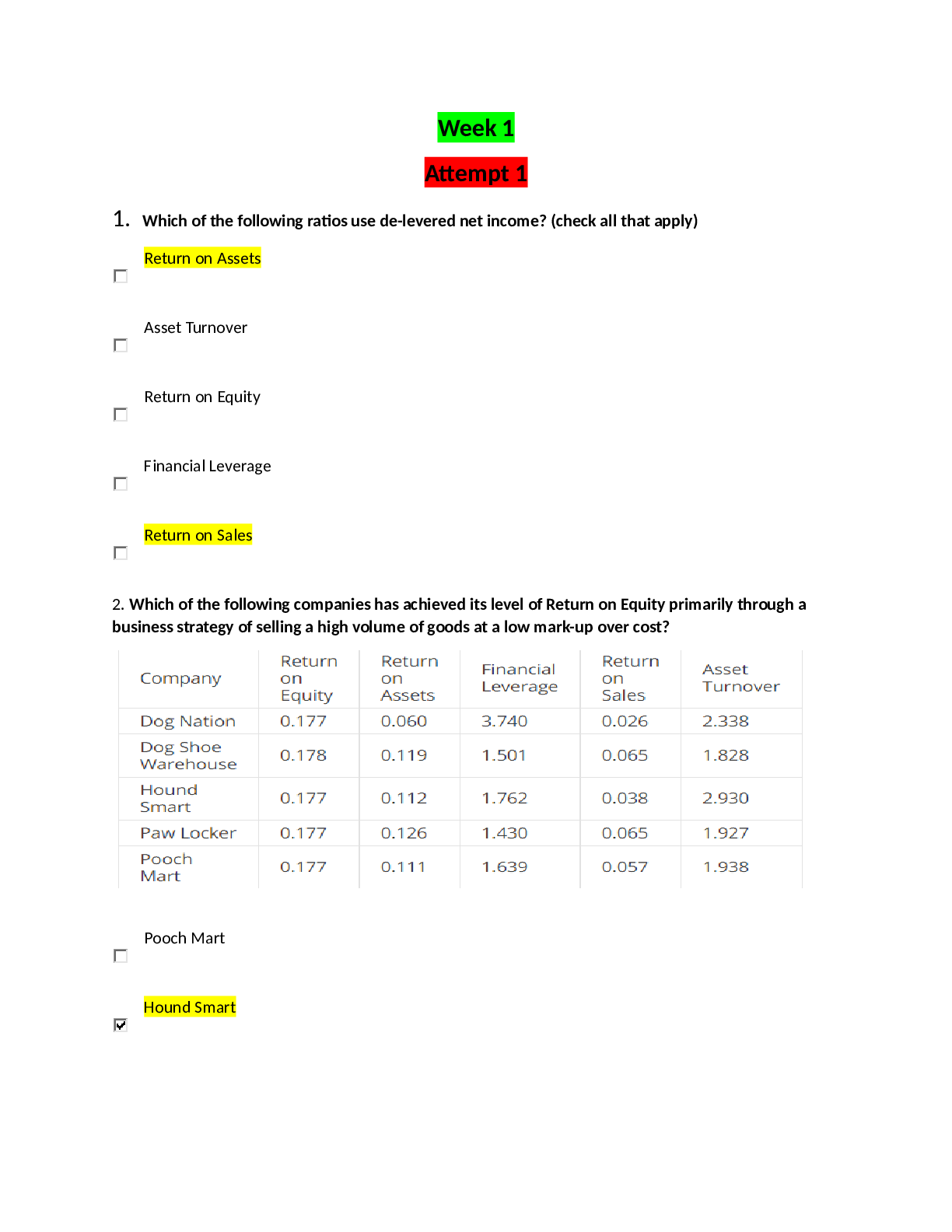
.png)
.png)
.png)
.png)
.png)
.png)
.png)

